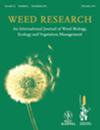Post‐attachment resistance to Striga hermonthica in finger millet (Eleusine coracana)
IF 2.4
3区 农林科学
Q2 AGRONOMY
引用次数: 0
Abstract
Finger millet is a highly nutritious and climate‐resilient cereal crop. Despite its importance, finger millet productivity in East Africa trails other cereals due to several biotic and abiotic factors, including the parasitic weed, Striga hermonthica. Striga spp. are noxious parasitic weeds whose damage can result in 100% yield losses in sub‐Saharan Africa. The objective of our study was to determine differences in post‐attachment responses of a selection of genotypes. We germinated finger millet in Petri dishes, transferred them to rhizotrons and infected the roots with Striga that had been pre‐conditioned for 7 days at 30°C and subsequently pre‐germinated using GR24. Histological analysis was done on three distinct genotypes to determine the host–pathogen interactions. The attachment of Striga onto the host was observed 3 days after inoculation. LESK10, a wild genotype, and OKHALE1 (cultivated) consistently supported fewer Striga plants after inoculation, while GBK029646A, a cultivated finger millet, consistently supported the highest. Histological analysis recorded an incompatible reaction in both OKHALE1 and LESK10 and a compatible reaction in GBK029646A as early as 3 days after infection. Our results suggest the likely existence of novel resistance in crop wild relatives that will be valuable for developing durable resistance to Striga in elite finger millet varieties.手指粟(Eleusine coracana)对Striga hermonthica的附着后抗性
黍是一种营养价值高、气候适应性强的谷类作物。尽管其重要性不言而喻,但由于包括寄生杂草 Striga hermonthica 在内的一些生物和非生物因素,东非的黍产量落后于其他谷物。Striga 属是一种有害的寄生杂草,在撒哈拉以南非洲地区,其危害可导致 100% 的产量损失。我们研究的目的是确定所选基因型附着后反应的差异。我们在培养皿中对小米进行发芽,然后将其转移到根瘤中,用在 30°C 下预处理 7 天并随后用 GR24 进行预发芽的 Striga 感染根部。对三种不同的基因型进行了组织学分析,以确定宿主与病原体之间的相互作用。在接种后 3 天,观察到 Striga 附着在寄主上。野生基因型 LESK10 和 OKHALE1(栽培型)在接种后支持的 Striga 株数一直较少,而栽培型小米 GBK029646A 支持的 Striga 株数一直最高。组织学分析表明,早在感染后 3 天,OKHALE1 和 LESK10 就出现了不相容反应,而 GBK029646A 则出现了相容反应。我们的研究结果表明,作物野生近缘种中可能存在新型抗性,这对开发优良小米品种对 Striga 的持久抗性很有价值。
本文章由计算机程序翻译,如有差异,请以英文原文为准。
求助全文
约1分钟内获得全文
求助全文
来源期刊

Weed Research
农林科学-农艺学
CiteScore
4.30
自引率
0.00%
发文量
41
审稿时长
12-24 weeks
期刊介绍:
Weed Research is an international peer-reviewed journal that publishes topical and innovative papers on weed science, in the English language. Its aim is to publish the best weed science from around the globe and to be the journal of choice for weed science researchers. It is the official journal of the European Weed Research Society. Papers are taken on all aspects of weeds, defined as plants that impact adversely on economic, aesthetic or environmental aspects of any system. Topics include, amongst others, weed biology and control, herbicides, invasive plant species in all environments, population and spatial biology, modelling, genetics, biodiversity and parasitic plants. The journal welcomes submissions on work carried out in any part of the world.
 求助内容:
求助内容: 应助结果提醒方式:
应助结果提醒方式:


